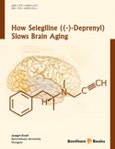This e-book is a reference on Selegiline ((-)-Deprenyl) effects on the brain.
Selegiline, described in thousands of research papers, is registered in over 60 countries. At present, more than one hundred preparations containing selegiline circulate in the global market under different brand names. They are widely used in the treatment of Parkinson’s disease, Alzheimer’s disease, major depression and as a geroprotective / anti-aging drug.
((-)-Deprenyl) selegiline, the first selective inhibitor of B-type MAO which, in contrast to the known MAO inhibitors, did not potentiate the effect of tyramine but inhibited it. The compound could be combined with levodopa in Parkinson’s disease without signs of hypertensive reactions. The DATATOP study in the USA revealed that (-)-deprenyl delayed the onset of disability associated with early, otherwise untreated Parkinson’s disease. The age-related decay of the supply of the brain with phenylethylamine (PEA), due to the progressive increase of MAO-B activity in the aging brain, and dopamine, due to the better than average decline of the dopaminergic neuronal activity during the postdevelopmental phase of life, are irresistible biochemical lesions of aging. The speed of deterioration of behavioral performances with the passing of time and longevity depends significantly on the pace of the worsening of these lesions. (-)-Deprenyl, increasing the supply of the brain with PEA and dopamine, counteracts this aging process. Maintenance of male rats from sexual maturity until death on ((-)-deprenyl) delays the age-related loss of the capacity to ejaculate, slows the age-related decline of learning ability and prolongs life. In humans, maintenance from sexual maturity on (-)-deprenyl (1 mg daily) is, for the time being, the most promising prophylactic treatment to fight against the age-related decay of behavioral performances, prolonging life, and preventing or delaying the onset of age-related neurodegenerative diseases such as Parkinson’s and Alzheimer’s.
This e-book is a useful reference for graduate medical students, academic researchers in the field of neuropsychopharmacology, neurophysiology and gerontology and professional research groups in commercial organizations manufacturing selegiline preparations.
Selegiline, described in thousands of research papers, is registered in over 60 countries. At present, more than one hundred preparations containing selegiline circulate in the global market under different brand names. They are widely used in the treatment of Parkinson’s disease, Alzheimer’s disease, major depression and as a geroprotective / anti-aging drug.
((-)-Deprenyl) selegiline, the first selective inhibitor of B-type MAO which, in contrast to the known MAO inhibitors, did not potentiate the effect of tyramine but inhibited it. The compound could be combined with levodopa in Parkinson’s disease without signs of hypertensive reactions. The DATATOP study in the USA revealed that (-)-deprenyl delayed the onset of disability associated with early, otherwise untreated Parkinson’s disease. The age-related decay of the supply of the brain with phenylethylamine (PEA), due to the progressive increase of MAO-B activity in the aging brain, and dopamine, due to the better than average decline of the dopaminergic neuronal activity during the postdevelopmental phase of life, are irresistible biochemical lesions of aging. The speed of deterioration of behavioral performances with the passing of time and longevity depends significantly on the pace of the worsening of these lesions. (-)-Deprenyl, increasing the supply of the brain with PEA and dopamine, counteracts this aging process. Maintenance of male rats from sexual maturity until death on ((-)-deprenyl) delays the age-related loss of the capacity to ejaculate, slows the age-related decline of learning ability and prolongs life. In humans, maintenance from sexual maturity on (-)-deprenyl (1 mg daily) is, for the time being, the most promising prophylactic treatment to fight against the age-related decay of behavioral performances, prolonging life, and preventing or delaying the onset of age-related neurodegenerative diseases such as Parkinson’s and Alzheimer’s.
This e-book is a useful reference for graduate medical students, academic researchers in the field of neuropsychopharmacology, neurophysiology and gerontology and professional research groups in commercial organizations manufacturing selegiline preparations.








